The Anesthesia Newsletter August 2021
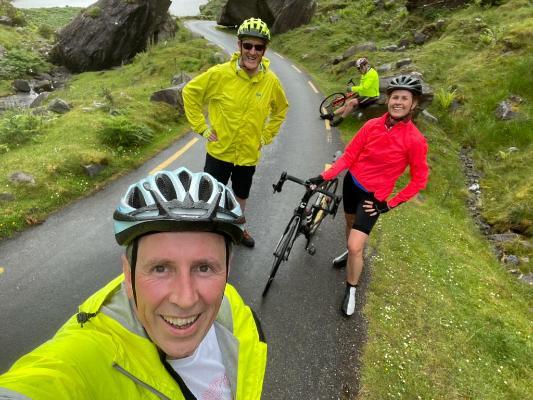
Hello everyone and welcome to the August edition of UCC Anaesthesiology News (UCC-AN). I’d like to thank Dr. Oonagh Hickey for welcoming me on board the editorial team as we take a monthly look at professional, academic and social events within the UCC Teaching Hospital Group’s Anaesthesiology Departments. If the catchphrase hasn’t already been commissioned, maybe we might consider rebranding the newsletter to “Yes UCC-AN”?
'Yes UCC-AN'
Dr Eoin O’Rathallaigh, SpR, CUH and co-editor
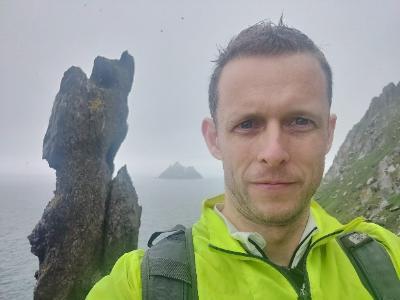
Firstly, we’d like to extend a warm welcome to our July intake of doctors-in-training. It’s great to see some familiar faces, and some new ones too, as we look forward to an exciting year ahead. Let’s hope the worst of the pandemic is behind us, the computer screens stay on, and the sun keeps shining.....
Many of our critical care medical and nursing staff were involved in last years Intensive Care Society of Ireland (ICSI) ICU 4 U charity cycle, which raised over 120,000 euros for four charities (Alone, Aware, Breakthrough Cancer Research and ICU Steps). For those interested in getting involved in the 2021 ICSI ICU 4 U Charity cycle, it will take place on Thursday 2nd and Friday 3rd September. Please find more information and registration details at the end of the newsletter and on the ICSI website www.intensivecare.ie . Final confirmation from HSE Public Health and the Cycling Captains from each hospital from each hospital is awaited in early August. The Department, the ICSI and CAI will be updated with the outcome of these decisions very shortly.
Thanks for reading; we hope you have enjoyed this brief overview of UCC Anaesthesiology activities over the past month. We look forward to bringing you our next newsletter and would like to welcome contributions from all Anaesthesiology Departments. If you have any departmental, educational or social pieces you would like us to feature, please get in touch at yesuccanews@gmail.com
Spotlight Section:
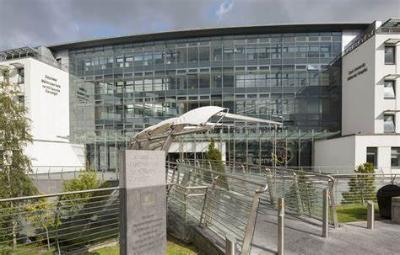
The Cork University Maternity Hospital: “One born every hour”
Dr Oonagh Hickey, Consultant Anaesthetist, CUH/CUMH
With about 8,000 deliveries a year, a baby is born nearly every hour at the CUMH. The Delivery Suite is a busy and dynamic place to work. The team looking after the mothers and babies of the region include anaesthetists, obstetricians, midwives, neonatologists and portering staff. With a caesarean section rate of >30% and an epidural rate of around 50%, an anaesthetist will be directly involved in about 2/3 of these deliveries. We are often also involved in the care of women undergoing pregnancy loss and women who become unwell during or after pregnancy. Particular challenges posed to anaesthetists include the physiological changes due to pregnancy, the urgent nature of some deliveries, and the fact that there are two (or more!) patients involved.
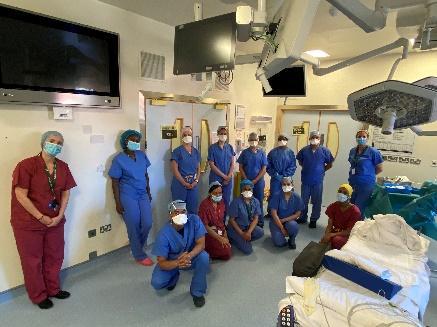
The CUMH is also home to a busy gynaecology service. The Da Vinci Surgical System plays a valuable role, facilitating minimally invasive surgery by an operator who sits remotely at a nearby console (photo). This poses unique challenges to the anaesthetist and requires excellent communication within the theatre team.
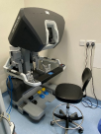
In-house obstetric anaesthesia training includes low fidelity simulation skill training and a Thursday morning obstetric anaesthesia lecture program. We also provide faculty for the COAST (Crisis in Obstetric Anaesthesiology Simulation Training) courses as part of the College of Anaesthesiologists of Ireland Simulation (CAST) program held at the ASSERT Centre at University College Cork. In pre-COVID times, we also supported the PROMPT (Practical Obstetric Multi-Professional Training) courses, which provided team training for anaesthetists, midwives and obstetricians in the management of obstetric emergencies. These courses are an excellent opportunity for staff from the different disciplines to meet and learn together outside the clinical area, and we hope that we can restart this program soon. Anaesthetists from our department are also regular contributors to Midwifery critical care teaching programs and to obstetric teaching programs. Other inhouse teaching includes Neonatal Resuscitation and Maternal Cardiopulmonary Resuscitation.
It is a privilege to work within such a highly motivated team who care for the women and babies of the region with such skill, compassion, and commitment.
Departmental updates:
CUH staff announcements: we wish to offer a warm welcome to Dr Sinead O’Keeffe and Dr Atilla Bonder, Consultant Anaesthetists, who have recently joined the CUH Anaesthetic Department.
CUH PNB Updates: Over the past 12 months, one of the CUH Peripheral Nerve Block fellows, Dr. Agatha Biculescu, has developed and delivered the “Block room” service in Theatre 9. As the COVID crisis consumed a vast amount of resources and bed capacity, this was the ideal and welcome opportunity to enhance the Regional Anaesthesiology service in the Plastics Trauma theatre.
Agatha’s skill, expertise and fantastic personality and leadership qualities have led to a reduction in waiting times for emergency cases, general anaesthesia administrations, recovery times and overnight stays. This is in addition to the many benefits for our patients, including reduced opioid consumption, faster recovery and discharge.
We are extremely proud of Agatha and her commitment and inspiration and look forward to supporting her in its future development.
Academic Updates:
ECHO teaching: Dr. Barry Kelly, Consultant Anaesthetist, CUH, has commenced a 12-week Echo teaching programme in the CUH ICU for interested Anaesthesiology and Cardiology registrars. Through a blend of didactic and practical teaching sessions, as well as a self-directed learning process, the programme aims to develop diagnostic proficiency in Point-of-Care-Ultrasound (POCUS) of the heart and lungs, and offers a springboard towards formal accreditation in Basic Critical Care Echocardiography (BCCE). Tuesday mornings of “Squeezy-bad, squeezy-good, or squeezy so-so?” are the new normal for now, and we wish Barry and his protégés every success with the programme!
AI and AKI: Dr Barry Kelly has had his review article entitled “"The Potential for Artificial Intelligence to predict clinical outcomes in patients who have acquired Acute Kidney Injury during the perioperative period" accepted for publication in the journal Perioperative Medicine. This covers an area of interest to Dr Kelly and one that he plans to develop in the future. His co-authors for this review article are Dr Julio Chevarria (Consultant Nephrologist), Professor Barry O’Sullivan (Director of the SFI Insight II Research Centre) and Prof George Shorten.
Gut Microbiome Project: Dr David Brenner’s innovative work on the influence of Gut Microbiome (diversity and composition) on postoperative pain has been accepted for publication in two forms by the Journal Neurobiology of Pain. The original work is the first examination of the association between GMB characteristics and somatic pain in humans. The findings suggest that preoperative interventions aimed at maintaining or enhancing GMB diversity may lessen the postoperative pain experienced by patients. Although preliminary, the findings justify an exciting avenue of investigation for perioperative pain management.
The work was conducted in collaboration with Dr Siobhan O’Mahony’s team at the APC Microbiome SFI Research Centre, Dr Catherine Stanton’s team at Teagasc and Dr Brian McNamara Director of Clinical Neurophysiology at CUH. The research team comprised of David Brenner Project Lead, Paul Cherry, Tim Switzer, Ihsan Butt, Catherine Stanton, Kiera Murphy, Brian McNamara, Gabriella Iohom, Siobhain M. O’Mahony, George Shorten.
The original article is entitled: Pain after upper limb surgery under peripheral nerve block is associated with gut microbiome composition and diversity.
Drs Brenner, Dr O’Mahony and Prof Shorten have also written a review article on this topic which will appear in the same issue of Neurobiology of Pain.
Recent publications:
-
The design and operation of non-invasive ventilators: practicalities, algorithms and engineering considerations. HMR Karim,, P. Bhakta, B O'Brien from Mechanical Ventilators for Non-invasive ventilation: Principles of Technology and Science. 2020 Nova Science A Esquinas (Editor).
-
Can TAP block, as a component of multimodal analgesia in robotic nephrectomy, offer long-term benefits without any medium-term effects? P Bhakta, B O’Brien and HMR Karim. Pain Med. 2021 May 21;22(5):1228-1229
-
Sarah Joyce O’Malley, Irish Anaesthetist (1896-1959) K. O’Brien and B O’Brien. Br J Anaesth. 2020 Mar;124(3):e187-e189.
-
Conscientious objection to provision of anaesthesia for termination of pregnancy amongst anaesthesiologists in the Republic of Ireland. C Mac Donnacha, J Brohan, B O’Brien. Br J Anaesth. 2020 Mar;124(3):e115-e116.
-
Anaesthesia and orphan diseases: Yellow nail syndrome. MZ Aslam, G De Loughry, B O’Brien. European Journal of Anaesthesiology 37(8):728-730, August 2020.
-
Prevention and prediction of post-surgical pain: comment. HMR Karim, B O’Brien, P Bhakta, MC Vassallo. Anesthesiology 2020 Apr;132(4):933-934.
- The effects of fascial plane blocks on chronic pain following cesarean section - too early for certainy? Our analysis of the study by Borys et al. p Bhakta, HM.R. Karim, BO'Brien, JK. Mitra. Anaesthesiol Intensive Ther 2020; 52, 1.
-
Preoperative frailty assessment predicts inferior quality of life outcomes up to one year after cardiac surgery: a prospective observational cohort study. P Bhakta, PK Delaney, J Brohan, U Singh, OE Williams, C Gormley, PC Sivadasan, B O’Brien. J Clin Anesth, Dec 2020; 67:109939..
-
Anaesthesia and orphan diseases: Bohring-Opitz syndrome. Barry D, MacSweeney K, Barry G, O'Brien B.Barry D, et al. Eur J Anaesthesiol. 2021 Jul 1;38(7):788-790.
-
Gastric emptying following tea with milk in pregnancy. P Bhakta, HMR Karim, B. O'Brien. European Journal of Anaesthesiology. 2021 Jan;38(1):82.
-
Observed links between cannabis consumption and volatile anaesthetic requirements warrant skepticism. HMR Karim, P Bhakta, B. O'Brien. J Clin Anesth. 2021 Feb; 68: 110085.
-
Barotrauma in covid - Causes and consequences. Bhakta P, Reazaul Karim HM, Mandal M, O'Brien B, Esquinas AM.Bhakta P, et al.Ann Med Surg. 2021 Apr;64:102189.
-
Peri-operative care of the cannabis user: practical considerations. Bhakta P, Karim HMR, O'Brien B, Bhakta P, et al. Eur J Anaesthesiol. 2021 Jun 1;38(6):664.
-
Arterial innervation, vasodilatation, and the resolution of ultrasound. Bhakta P, O'Brien B, Zaheer H, Bhakta P et al. Anaesth Crit Care Pain Med. June 2021.
-
Anaesthetising the septic patient: Comparing drug combinations. Bhakta P, Karim HMR, Mandal M, O'Brien B. Anaesth Crit Care Pain Med. 2021 Jun;40(3).
Getting to know the team:
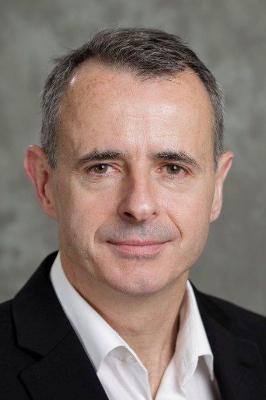
Professor George Shorten, Consultant Anaesthetist CUH and President of the College of Anaesthesiologists of Ireland.
1. What, or even who, lead you to choose anaesthesia as a career? More or less accidentally, I was more interested in maths.
2. If you were to choose another medical specialty, what would it be? Maybe (interventional) radiology.
3. What book or film would you recommend to a young doctor? A Medical Case, by Anton Chekhov.
4. Tell us something surprising about yourself, eg some non-medical area you are really interested in, or fascination you have? I really enjoyed hitch hiking as a teenager and young adult.
5. What would be your ideal weekend or holiday? Feet up in west Cork?
6. If you could go back five or ten years and give yourself advice, what would it be? Seek out good people and listen to them.
7. Is there anyone you regard as your idol or hero? Alexander the Great.
8. What ability, gift, or even superpower, would you most like to have? Amor fati!
Social activities:
Club Velo-
Dr Frank Loughnane, Consultant Anaesthetist, CUH
The final Club Velo cycle ride of the first six months took place in Killarney on July 4. The route extended from Killarney through the Gap of Dunloe and the Black Valley up to Moll’s Gap and back into Killarney; a loop of about 60km.
We had 14 participants on this ride and despite the rain completed the circuit in less than 4 hours including coffee breaks at both Lord Brandon’s Cottage and Lady’s View.
There were a number of challenging climbs on the way around which everybody managed to negotiate. Unfortunately, no rainbows were witnessed so the crock of gold remains undiscovered. The ‘Little People’ did make an appearance but a bit like the ‘Invisible Gorilla Experiment’ people were concentrating on the hill climbs so intently that they failed to notice ;). But the group were finally rewarded with a 15km triumphant downhill return into Killarney.
Following a quick dry and change we headed to the Killarney Golf and Fishing Club for a late lunch overlooking Lough Leane before returning to Cork in time for tea.
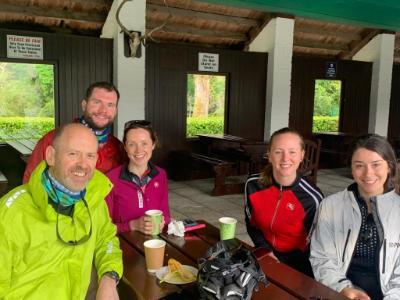
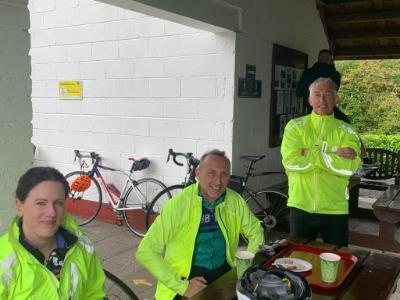
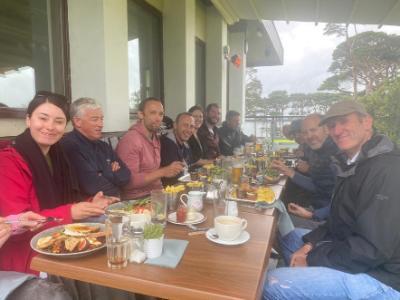
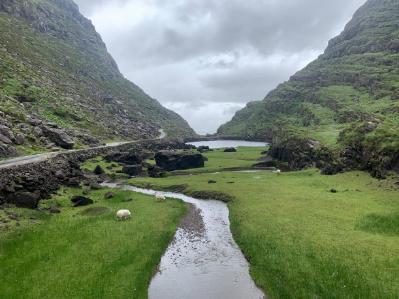
Good news:
Dr Aaron Blake, SAT, Dr Eoin O’Rathallaigh, SpR, CUH
Olympic news:
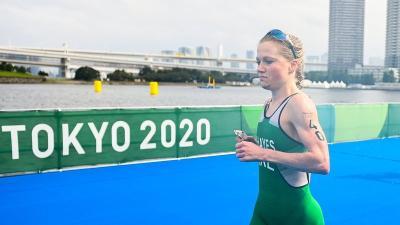
Congratulations to Dr. Carolyn Hayes, who finished in second place at the World Cup Triathalon in Lisbon on 23rd May. On 27th July, she competed in the women’s triathlon in Tokyo, putting a magnificent performance, coming 23rd. Dr Hayes is joining the CUH Anaesthetic Department in July. We’re delighted with her achievements and look forward to working alongside her over the coming year. She has promised not to disgrace us on our departmental cycles.
Editor’s note: There is possibly more lycra in the current CUH aesthesiology crew, some of whom have been known to dabble in Ironman, triathalon, marathons, charity swims, etc....
Galley Head Swim:
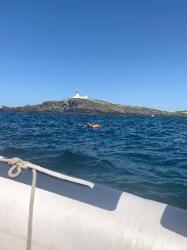
Speaking of lycra, a massive congratulations to Dr. Brian O’Donnell who recently swam the 10km Galley Head swim, raising 3,955 euros in aid of Marymount University Hospital and Hospice and West Cork Underwater Search and Rescue. The swim took place on a beautiful July morning, taking off from Red Strand outside Clonakilty, out around the Galley Head Lighthouse and finishing on Warren Beach in Roscarberry. Brian’s support boat was skippered by Captain Frank Loughnane who ensured his safe passage to Roscarberry in a stellar time of 3 hours and 32 minutes. Well done to all involved for worthy local charities!
Of note, the Irish Heritage Trust maintains two lightkeeper’s houses at Galley Head Lighthouse station, perfect for a break on the doorstep to West Cork. For more information visit www.irishlandmark.com.
Baby news:
A massive congratulations to Dr Claire McSweeney and her husband on the birth of their second baby girl, Julia!
Claire was a Dublin blow-in in the CUH Anaesthetic Department in the last year and kept us all well entertained with her general wit and fun (and wishing she was a Cork woman, naturally).
If Claire's humour and personality is anything to go by, Julia will have the whole family laughing in no time. We wish her and her family all of the absolute best!
Random Historical Stuff:
“Okay Houston, we’ve had a problem here”;
The world’s most famous carbon dioxide absorber.
The next time that you are struggling with a soda lime cannister, spare a thought for the crew of Apollo 13.
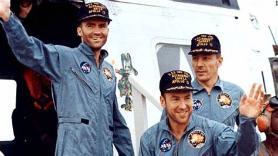
When Commander James Lovell, Jack Swigert and Fred Haise blasted off from Kennedy Space Centre atop the massive Saturn V rocket on April 11, 1970, the American public were already losing interest in the Apollo program. With two successful lunar landings already accomplished, space travel was almost becoming mundane. This would change when a routine stir of an oxygen tank resulted in an explosion that ripped through the service module and resulted in oxygen venting into space. Oxygen was needed for generating electrical power and a decision was rapidly made to shut down all systems in the Control Module. The crew now had to rely on the Lunar Module as a “lifeboat”. The lunar module had been designed to take two men to the moon and to sustain them for two days- now it needed to support three men for four days. Committed to its mission to circle the moon before attempting re-entry, the challenge was to keep the men alive in the meantime.
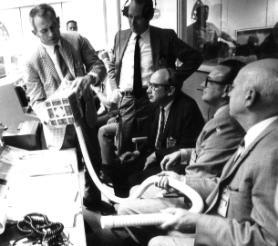
The Lunar Module carried enough oxygen for breathing, but a big challenge was removal of carbon dioxide. The Lunar Module had cannisters of lithium hydroxide, but not enough to last for the return journey. The Control Module had canisters, but they were the wrong shape and size to work with the Lunar Modules equipment. Engineers worked around the clock to come up with a solution, using equipment immediately available to the men in the stricken space craft. Finally, they developed a system using cardboard procedure manuals and duct tape to produce “the mailbox”. Following instruction from the CAPCOM, Swigert and Haise assembled the device (photo). Carbon dioxide levels on board began to fall. They were cold, dehydrated, but still alive.
On April 17th, the crew of Apollo 13 successfully splashed down in the South Pacific. The Apollo 13 Mission was deemed “a successful failure”.
Recommended movies: “Mission Control”- a fantastic documentary (2017).
“Apollo 13” (1995), a dramatized version of the mission. The captain of the recovery ship USS Iwo Jima who greets Tom Hanks is none other than Jim Lovell.
The world's most famous carbon dioxide absorber (howequipmentworks.com)
ICU 4 U2: Intensive Care Society of Ireland (ICSI) Charity Cycle:
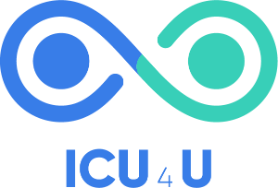
NB: Final confirmation from HSE Public Health and the Cycling Captains from each hospital from each hospital is awaited in early August.
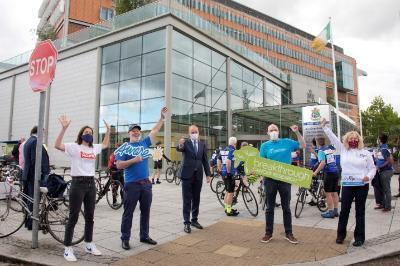
1. Idea: In September 2020, a group of Irish ICU Doctors and Nurses organised the ICU 4 U Charity cycle. At the time we felt uncomfortable with being labelled heroic and frontline staff and wanted to turn the focus back on the patients and families of those affected by the COVID 19 crisis, rather than it being on us. Particularly we wanted to turn the focus on the elderly, those in nursing homes, those suffering from anxiety/mental illness, Covid-19 ICU survivors and victims of cancer who had their management interrupted or delayed because of the Covid-19 crisis. We cycled from the 4 corners of Ireland to Dublin and raised over 120,000 Euros for 4 charities – Alone, Aware, Breakthrough Cancer Research and ICU Steps (all related to the above issues we wanted highlighted). As the pandemic in Ireland comes to an end and our country reopens, we feel strongly we must not forget the tragedy that some families endured with the deaths of their loved ones in our ICUs, hospitals and nursing homes during this difficult time. We want to do a cycle of remembrance for these victims of the pandemic, called The ICU 4 U 2 Charity cycle and give any monies raised back to these same 4 charities.
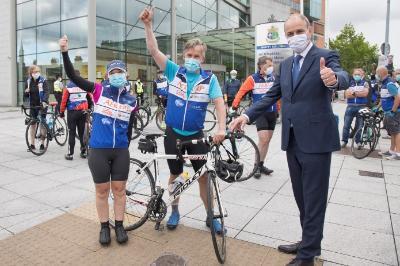
2. Proposal: A white rose will be collected for each death that occurred in our country (sadly estimated to be over 7000 by summer’s end of 2021). Teams of cyclists, who will be doctors, nurses, local GPs, paramedics, ambulance drivers or other staff members (some gardaí will also be joining us this year) will leave from one of 6 nationwide University hospital locations in Cork, Belfast, Galway, Limerick, Sligo and Waterford, carrying with them some of the roses. Cyclists from the Dublin Hospitals will go out to meet those coming from the provinces at their half way points of Portlaiose, Dundalk, Athlone or Kilkenny. Each of the separate routes will finally meet in The Memorial Gardens at Islandbridge, Dublin on the evening of Friday 3rd September. A floral tribute will be made with the over 7000 roses to commemorate those that lost their lives to Covid during the pandemic. After a brief commemoration event, 32 roses (symbolising the deaths that occurred in each county on our island) will placed in or near the river. Permission from both the Office of Public Works and Dublin City Council has been granted for the event. The cycle will be over two days from the Southern cities and over one day from Belfast. Restrictions and Government Regulations will be strictly observed at all times regarding number of cyclists, social distancing and congregating. HSE Public Health have been informed and given provisional approval but final confirmation will be sought closer to the date, pending any further developments in the pandemic. Approval for the cycle has been granted by Cycling Ireland (www.cyclingireland.ie).
3. Fundraising: Will be similar to what occurred for ICU 4 U, via the internet site “iDonate” plus approaching large organisations for sponsorship i.e. Pharmaceutical companies, Medical Equipment companies, Supermarkets, Banks and other businesses. Publicity will be managed by ETC PR & Marketing via Social Media sites, the internet, the national & local media (newspapers, radio and TV interviews). The goal will be to raise 100,000 Euros or potentially more for the charities.
4. Charities to benefit:
- ALONE (helps our more vulnerable Elderly population) www.alone.ie
- Aware (supports people with Mental Health problems) www.aware.ie
- Breakthrough Cancer Research (supports improvements in the care of Cancer patients) www.breakthroughcancerresearch.ie
- Aware NI (supports people with Mental Health problems in Northern Ireland) aware-ni.org
5. Media involvement: As was so successful for ICU 4 U, we plan to again approach prominent Irish Media, Music and Sports personalities to support us. For ICU 4 U we were very fortunate to be supported by TV Celebrity Graham Norton, the Olympic Rower Paul O’Donovan, Radio Presenter Philip King, Hotelier and TV Personality John Brennan and Lead singer of the band “Walking on Cars” Patrick Sheehy and The Munster Rugby Team. Each kindly supported us with some photo opportunities and agreed to highlight/Tweet us to their followers. We plan to also use the same PR company as was used for ICU 4 U which so successfully promoted our event, ETC PR & Marketing lead by Niamh Murphy (087 0617705).
6. Dates: The ICU 4 U 2 will take place on Thursday 2nd & Friday 3rd of September 2021.
7. Training: Individuals will train themselves locally within the radiuses allowed. In August, a small group of cyclists will cycle part or all of the five Rings of West Cork & Kerry on each of the five Sundays in August. Please contact Dr Patrick Seigne (086 8222782), if interested, for further details.
- Mizen peninsula – Bank Holiday Monday August 2nd
- Sheeps Head peninsula - Sunday 8th August
- Beara peninsula- Saturday 14th August,
- Ring of Kerry- Sunday 22nd August
- Dingle peninsula –Sunday day 29th August
Other regions may want to do similar training cycles i.e. The Ring of Connemara, The Copper Coast Cycle, The Wicklow 200, The Ring of Clare Cycle or The Mourne Mountain Cycle Loop. These will be organised by local ICU 4 U 2 cycling captains (contact details available on ICSI registration site).
8. Education: An ICU4U 2 Educational Webinar has been organised jointly by The College of Anaesthesiologists of Ireland, The Intensive Care Society of Ireland and The Joint Faculty of Intensive Care Medicine of Ireland) for the following day, Saturday September from 8am until 1pm (further details and the full speaker will shortly be available on the ICSI website (www.intensivecare.ie). There are two scientific sessions, the first being The Kate Flynn prize again. The speakers for the second scientific session and the third session (which will again be open to the general public as it was so successful last year) have yet to be confirmed.
9. Registration: Registration for the ICU 4 U 2 cycle is required. There will be several options, dependant on number of night’s accommodation (strictly single hotel rooms) required and days of cycling. It is through a link on the ICSI website (www.intensivecare.ie). Included will be all refreshments during the cycle, backup mechanical and medical support during the cycle, hotel accommodation, breakfast and evening dinners (strict social restrictions will be observed). You will need to book the hotel accommodation yourself but the cost will be included in the registration.
